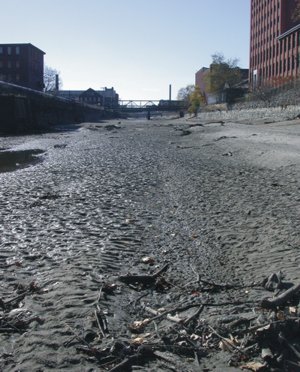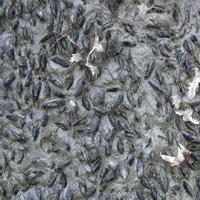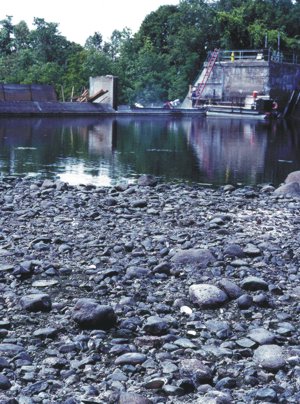|
Freshwater Mussels and Dam Removal
While fish and birds may thrive, these vulnerable mollusks often perish
Printer Friendly Page
By Ethan Nedeau
FRESHWATER MUSSELS do not like change. They are like the elderly couple down the street that has lived in the same 19th century farmhouse for decades, endured the Great Depression, and clung ever more tightly to their traditions as they watched the world change around them. This quality is incompatible with the rate at which humans alter streams and rivers, making freshwater mussels one of the most endangered groups of species on Earth. River restoration is gaining momentum in the Gulf of Maine region and resource managers are seizing the opportunity to undo many of the large-scale changes that were wrought decades or centuries ago. But change is change, and mussels deserve special consideration as we return rivers to their natural state and destroy habitat that they have come to rely on.
 |
Freshwater mussels are abundant in the Holyoke Power Canals in Holyoke, Massachusetts. The canals are drawn down for maintenance periodically. The photo above, taken in an empty canal, shows a dense bed of eastern elliptio, a common species in northeastern rivers. In this bed alone there are probably 300 to 400 of the mussel species per square meter. The state endangered yellow lampmussel also exists in the canals.
PHOTOS: ETHAN NEDEAU
|
 |
Some freshwater mussels live longer than 100 years, though most species in the Gulf of Maine region live for 10 to 30 years. They have delayed maturity, meaning they often will not begin to breed until five to 12 years of age and thus the population growth rate is slow. Although adults are free-living, larvae must attach to the fins or gills of a host fish to develop into juveniles. Mussels are often very finicky about which fish they will use. Even in perfect habitat, mussels may not reproduce if their host fish are not present during the spawning season. The likelihood of larvae encountering and attaching to a suitable host can be extremely low, as is the survival rate of juvenile mussels. Mussels may move no more than a few feet during their adult lives, and the only time that they can move great distances is during the larval phase when they are hitchhiking on fish.
Mussels either persist or die; because of movement no quicker than that of a garden slug, they cannot escape an area if conditions become inhospitable. Once gone from an area, it may take years or decades for them to return, depending on the distance to the closest viable population. In many cases, there are no viable populations within the same river or watershed and mussels will never return. In North America, 19 species ran out of viable populations and went extinct in the last 100 years, and another 62 species are federally endangered and at risk of extinction. Of the 13 species native to the Gulf of Maine watershed, one is extirpated, and six others are listed as endangered, threatened or of special concern by one or more states.
Dams have had a great effect on freshwater mussels throughout North America. In the United States, there are more than 75,000 dams above two meters, or about seven feet tall, which collectively obstruct nearly 950,000 kilometers [590,000 miles] of waterways. Mussels reach their greatest diversity in running waters and damming these rivers has caused precipitous declines in freshwater mussels both upstream and downstream of dams. Many species are unable to tolerate impounded environments and unable to move. Dams fragment rivers, isolate populations, block movement of fish and change physical habitat. A population resilient enough to survive short-term effects of dam construction may face a greater extinction risk because of the long-term effects of dams.
Trying times for mussels
The fervor of dam construction is now being replaced with a growing fervor of dam removal as a way to restore rivers. By 2020, 85 percent of all government-owned dams in the United States will have reached the end of their design lifespan and will need to be repaired, rebuilt or removed. Countless dams no longer serve their original purpose and do nothing but hold back water. Dam removal is emerging as a feasible option, especially where the costs of repairs outweigh the costs of removal and the benefits of keeping the dam. Many dams are simply left to the erosive forces of water since there is little funding to actively remove them. Small dams throughout the Gulf of Maine region are breached during floods, leading to an uncontrolled and often dangerous draining of the impoundment.
 |
| The Halifax Dam on the Sebasticook River in Maine. The impoundment was drawn down to conduct dam maintenance but the draw down occurred without knowing that a strong population of yellow lampmussels and tidewater muckets existed in the impoundment. Thousands of animals perished in the hot days that ensued.
|
 |
| What level of mortality are we willing to accept, especially for endangered or threatened species, as an unfortunate and inevitable consequence of restoring rivers?
|
Whether dam removal is active, with heavy equipment and expectant onlookers, or passive, by ignoring decrepit dams until they finally collapse, it is important to consider the ecological costs of dam removal and loss of the impoundment. Most studies that have described the biological response to dam removal have focused on fish or benthic macroinvertebrates that are highly mobile or have short life cycles and can rapidly disperse into new habitats. Dams obviously impede fish, and within days of removing a dam, fish can be documented swimming upstream. However, mussels are not so adaptable; mussels are much more glacial in their response to habitat modification. Freshwater mussels will be no more happy about dam removal than they were about dam construction, at least not in the short term, because it represents a dramatic change in their habitat that they are ill-equipped to tolerate. The initial effect of dam removal on mussels is high mortality, and the long-term effect is poorly documented because of the timeframe involved and lack of monitoring. In some cases, it might take five, 10, or even 25 years for mussels to show a positive response to dam removal.
When a dam is breached and the water levels drop in the impoundment, mussels will move slowly toward deeper water, as long as they are in fine substrates (silt, sand and gravel) that they can move through and if there are no obstructions. Mussels will often amass behind boulders or logs that block them from moving farther into the river. Some mussels move into pools that are then cut off from the river and become too hot or evaporate, causing all mussels to perish. Many mussels respond by burying themselves up to 70 centimeters [28 inches] deep, a behavior that enables them to survive short-duration dewatering events. But when dewatering is permanent, such as when a dam is removed and an impoundment is drained, these mussels are digging their own graves. In addition, studies have shown that 25 to 50 percent of the mussel population at any given time (a higher percentage during colder months) are buried, particularly juveniles. These mussels cannot respond to dewatering. When an impoundment is drained, perhaps more than 90 percent of the total standing crop of mussels in the dewatered area will die from thermal stress, desiccation and predation by opportunistic raccoons, skunks or gulls.
Mussel habitat can be limited or patchy in some streams and rivers, either for anthropogenic reasons such as land use and water withdrawals that degrade habitat and reduce flows, or for natural reasons such as steep topography or prevalence of bedrock. Some mussel species in the Gulf of Maine region flourish in lake-like conditions upstream of large dams, or upstream of small run-of-the-river dams whose impoundments retain flowing water and stream-like conditions but with the added benefit of hydrologic stability. Impoundments may support the only viable mussel populations in these rivers or watersheds. Some dams may have unintended positive effects on mussel communities by impeding non-native fish (such as smallmouth bass or northern pike) that might otherwise overrun a watershed and outcompete native stream fish that are important hosts for mussels. Yet, dams also block native species, halting migration routes and fragmenting fish communities, and this has had a tremendous effect on freshwater mussels throughout North America.
Some species thrive downstream of dams because dams often provide stable flow and temperature. Water exiting impoundments is often rich in nutrients due to algal production in the impoundment, creating abundant food for filter-feeding animals such as mussels. Mussels are more likely to flourish downstream of smaller dams and flood control dams, whereas populations that are downstream of large hydroelectric dams are usually sparse because of prohibitive flow regimes and armoring of the streambed.
 Dam removal has a number of downstream effects, but of greatest consequence for mussels is the release of large amounts of sediment. The volume and movement of sediment depends on the nature of the dam, flow regime of the river, sediment stabilization efforts during the removal process and precipitation. Sediment can smother mussels, clog their gills and cause mortality if sedimentation is high and persistent.
Dam removal has a number of downstream effects, but of greatest consequence for mussels is the release of large amounts of sediment. The volume and movement of sediment depends on the nature of the dam, flow regime of the river, sediment stabilization efforts during the removal process and precipitation. Sediment can smother mussels, clog their gills and cause mortality if sedimentation is high and persistent.
The Wisconsin study
One of the few published studies on the effect of dam removals on mussels was conducted in Wisconsin, where a small dam on a 5th order stream (average width=10 meters or 33 feet) was removed. The study documented 95 percent mortality of mussels in the former impoundment due to desiccation and exposure. Downstream migration of silt and sand from the former impoundment smothered mussel beds, as silt increased from 16.8 percent to 30.4 percent of the total area sampled, and sand increased from 1.1 percent to 15.9 percent between fall 2000 and summer 2003. Mussel densities declined downstream of the dam, and one rare species was extirpated from the community altogether. This study was eye opening for dam removal advocates because it sent an unequivocal message that there are serious consequences of dam removal that need to be addressed before projects begin. The authors of the paper espouse dam removal as a restoration option, but they remind us that we should proceed cautiously to minimize adverse effects (see citation in source box).
Should we view impoundments as mussel habitat that we should protect, or an artificial habitat that we can take away because we created it in the first place? Once created, should artificial habitats earn the same protections as natural habitats? The issue becomes even more contentious when we consider that state and federal endangered species laws protect many freshwater mussel species. For these species, there is a strong legal mandate to not “harass, harm, pursue, hunt, shoot, hound, kill, trap, capture, collect, process, disrupt the nesting, breeding, feeding or migratory activity or attempt to engage in any such conduct” (Massachusetts Endangered Species Act). What level of mortality are we willing to accept, especially for endangered or threatened species, as an unfortunate and inevitable consequence of restoring rivers and improving conditions for other species, such as migratory fish? If we are to proceed with dam removal despite the presence and habitat requirements of freshwater mussels, citing long-term ecosystem benefits rather than short-term losses, then what steps can we take to ensure that dam removal does not cause irreparable harm to mussel populations?
A growing number of dam removal projects enlist a crew of volunteers to walk the shoreline and relocate mussels to deeper water, but there is little empirical data on the percent of the population that is relocated, habitat suitability in areas where mussels are moved to, survival of relocated mussels, or the recovery of populations within affected areas. Specific methods and guidelines are generally lacking or are difficult to implement for large projects where mussel populations may number in the tens to hundreds of thousands and where environmental conditions make surveying difficult. Due to a lack of funding or expertise, long-term monitoring is rarely conducted.
Solutions: long-term monitoring
The yellow lampmussel (Lampsilis cariosa) and tidewater mucket (Leptodea ochracea) are two species that thrive in impoundments and are listed as endangered or threatened by every New England state that has populations of these species. Significant mortality of these species occurred when impoundments were drained for dam maintenance or removal, including the Sebasticook River (Halifax Dam, 1998), Passadumkeag River (Lowell Dam, 1998), and Kennebec River (Edwards Dam, 1999). The Sebasticook River event killed thousands of mussels and caught state biologists by surprise, whereas the Passadumkeag and Kennebec projects had volunteers combing the shoreline to find mussels and move them into deeper water. Six hundred and seven tidewater muckets and 16 yellow lampmussels were rescued when the Edwards Dam was removed, yet it is not known what proportion of the original population these animals represented, nor did anyone return to see how these mussels had fared after being moved.
Aside from relocating mussels, two other options to minimize mortality are to conduct the drawdown very slowly (months to years) to allow mussels to adjust to changing water levels, and to stabilize sediments within the impoundment. Neither of these options were implemented in the Wisconsin study described above, and the result can be considered a worst-case scenario for the effect of dam removal on mussels. The Gulf of Maine region needs more case studies and success stories to gain confidence that dam removals can be done without catastrophic effects on mussels.
Perhaps of greater concern than purposeful dam removals are dams that are breached by storm events, leading to uncontrolled emptying of the impoundment. Floods breached several dams in the Gulf of Maine region in October 2005 and June 2006. There was no time to prepare for these events, conduct pre-removal monitoring, or develop mitigation measures. Since these events occurred during floods and threatened human life, property and other infrastructure, freshwater mussels were not a priority and it was weeks before the ecological damage was assessed. A proactive approach might involve screening decrepit dams likely to be breached by 50-year or 100-year floods, characterizing the ecological importance of their impoundments and downstream areas, and developing a rapid response protocol for when a breach occurs.
While it is important to be aware of potential positive and negative effects of dams and dam removals on freshwater mussels and all other native species, generalities often impede critical review and creative solutions. Each dam is different, and the ecological context of a dam should be carefully considered and communicated to all stakeholders. The Gulf of Maine Council is currently engaging regional scientists and managers to develop river restoration monitoring standards specific to the Gulf of Maine region. This effort has opened constructive dialogue on what, why and how we should be monitoring barrier removals. Standardized monitoring will improve the ability to assess the long-term benefits of restoration, develop more effective restoration techniques and communicate results to stakeholders and the public. Freshwater mussels are just one of the groups of animals that could be measured, along with fish or other benthic macroinvertebrates. However, mussels will challenge our resolve to restore rivers in the most environmentally friendly way because they are likely to suffer in the short-term, and the long-term effects may never be documented unless we plan carefully and commit to long-term monitoring.
Some of the sources used for this article:
Nedeau, E.J, M.A. McCollough, and B.I. Swartz. 2000. The Freshwater Mussels of Maine. Maine Department of Inland Fisheries and Wildlife, Augusta.
Sethi, S.A, A.R. Selle, M.W. Doyle, E.H. Stanley, and H.E. Kitchel. 2004. Response of unionid mussels to dam removal in Koshkonong Creek, Wisconsin (USA). Hydrobiologia 525:157-165.
Vaughn, C.C., and C.M. Taylor. 1999. Impoundments and the decline of freshwater mussels: a case study of an extinction gradient. Conservation Biology 13:912-920.
Watters, G.T. 1995. Small dams as barriers to freshwater mussels (Bivalvia, Unionoida) and their hosts. Biological Conservation 78:79-85.
© 2006 The Gulf of Maine Times
|





 Dam removal has a number of downstream effects, but of greatest consequence for mussels is the release of large amounts of sediment. The volume and movement of sediment depends on the nature of the dam, flow regime of the river, sediment stabilization efforts during the removal process and precipitation. Sediment can smother mussels, clog their gills and cause mortality if sedimentation is high and persistent.
Dam removal has a number of downstream effects, but of greatest consequence for mussels is the release of large amounts of sediment. The volume and movement of sediment depends on the nature of the dam, flow regime of the river, sediment stabilization efforts during the removal process and precipitation. Sediment can smother mussels, clog their gills and cause mortality if sedimentation is high and persistent.